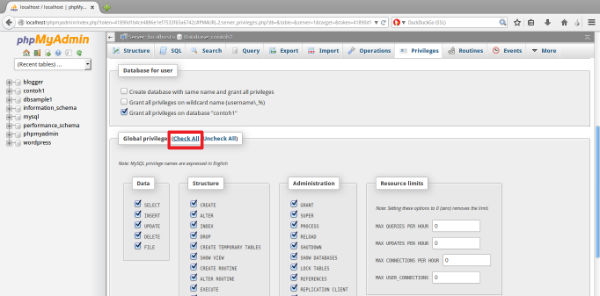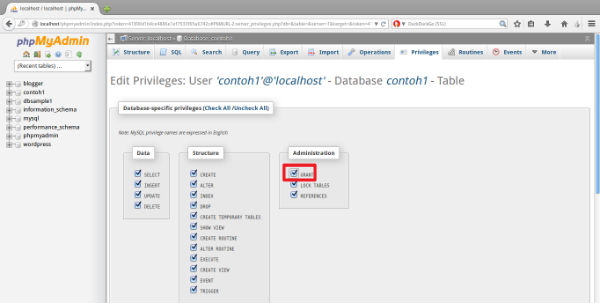

- Phpmyadmin no privileges install#
- Phpmyadmin no privileges update#
- Phpmyadmin no privileges full#
- Phpmyadmin no privileges password#
- Phpmyadmin no privileges download#
At this prompt type the following: (Where ******** is the new password, NOTE: the single quotes ARE REQUIRED) mysql> UPDATE er SET Password=PASSWORD('********') WHERE User='root' įlush privileges will make the change take effect immediately.
Phpmyadmin no privileges password#
To change the mysql password for the root user, do the following: PS: contains more interesting settings :)įollow the root password change if you dont know the root password and then login in, it worked for me. So you get: $cfg = 'cookie' (or http if you wish)ģ) clear/delete all browser cookies for your server (usually look for localhost or 127.0.0.1 cookies)Ĥ) Go to phpyadmin's webpage again - now you will be prompted with login box (html or http - depends on whether you set the cookie or http)ĥ) LOGIN - AND YOU'RE DONE ! :) Suddenly 'Privileges'/'Users' tab is shown, the exit button appears suddenly too ! :) (next to the "little house"-left-top) $cfg = 'SOMETHING' - change 'SOMETHING' to 'cookie'

After you have installed MySQL, and you login to the web interface phpmyadmin with the root username and password, you may find that when you. This page describes the issue of no privileges when trying to create a new database in the MySQL web interface phpmyadmin. SET PASSWORD FOR = PASSWORD('YOURPASSWORDHERE') Ģ) Search for in your wamp/xampp folder and change auth_type: 18) No Permissions, no Privileges for login to phpmyadmin MySQL on Raspberry Pi.
Phpmyadmin no privileges full#
Permit the Superuser to full privileges GRANT ALL PRIVILEGES ON *. Create the Magento Database User CREATE USER IDENTIFIED BY 'PqQGjP9E9EQjENj9lqofjof9l' ģ. MySQL Superuser Password: PqQGjP9E9EQjENj9lqofjof9lĢ.MySQL Superuser Name: bob_the_superuser.

Permit the Magento User to access the Magento Database GRANT SELECT, INSERT, UPDATE, DELETE, CREATE, DROP, INDEX, ALTER, CREATE TEMPORARY TABLES, LOCK TABLES, EXECUTE, CREATE VIEW, SHOW VIEW, CREATE ROUTINE, ALTER ROUTINE, TRIGGER, REFERENCES ON magento_database.* TO Exit MySQL Create the Magento Database User CREATE USER IDENTIFIED BY 'QGENj9lqofjP9EQj9lqofjP9E' Ĥ. Create the Magento Database CREATE DATABASE magento_database ģ. You’ll be prompted for your MySQL root user password. Log into MySQL from the Command Line sudo mysql -u root -p
Phpmyadmin no privileges install#
How do I create a user and database to install Magento? In this case, the security measure is to disable using your MySQL root user on phpMyAdmin.Ī.
Phpmyadmin no privileges download#
The repositories in Ubuntu 18.04 appear to download a newer version of phpMyAdmin that comes with an extra security measure. There is an easy fix to getting things done here, and you just have to make sure that you are logging in with some account that has the right credentials and access to configure everything you need to. I was able to reproduce this issue after installing phpMyAdmin on Ubuntu 18.04. A member of our community brought up an issue he ran into the other day.


 0 kommentar(er)
0 kommentar(er)
